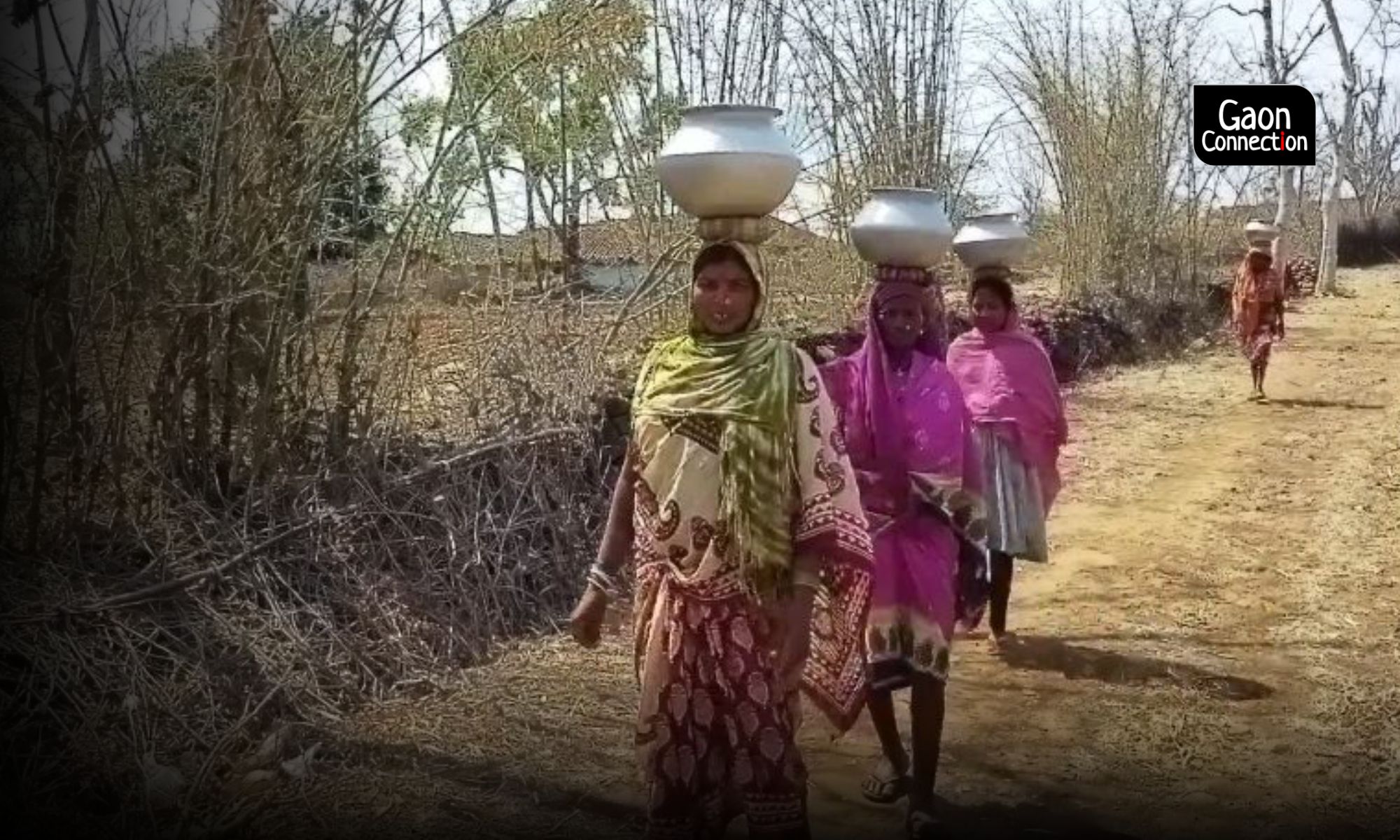Deori Mal, Madhya Pradesh
At the break of day, most villagers of Deori Mal in Madhya Pradesh head to the Narmada river, one-and-a-half kilometres (km) away, to fetch water. In the height of summer, in May and June, they just set up camp on the river banks, along with their cattle.
“We do not have drinking water here at the village, let alone for bathing and washing,” Jahangir Dhurwe complained to Gaon Connection. Because of this, nearly half the residents have left the village and gone away, the 32-year-old added. Due to water scarcity, of the official population of 669 people in this village in Dindori district, barely 350 currently live there.
Due to water scarcity, people in this village have been forced to drink water from the polluted river Narmada. Fetching water from the Narmada is also an arduous task. The route to the river bank is uneven and rocky and people often fall and injure themselves.
The nearest hospital is 20 km away in Shahpura. There is no regular public transport to go there from the village, so one has to arrange for private transport.
“If someone is injured, they treat themselves, because the hospital is far away and there is no regular public transport. Once the vehicle leaves in the morning, it only returns in the evening,” Kali Bai, another villager, complained. “Farming, food, firewood, transportation, hospital… you name it, and we suffer from lack of these amenities,” the 60-year-old said.
Many times, marriage proposals from the village are turned down because of the acute water shortage. “The problem is so bad that many girls who are married into the village either leave or stay back and suffer like us,” rued 47-year-old Phoolwati Bai Uike.
Pointing to the grimy clothes he was wearing, 60-year-old Bhura Singh said shortage of water made it impossible to carry out even the most basic washing.
For some, like Balmohtin, the shortage of water became a lifelong nightmare. She vividly recalled the day 11 years ago when she had gone to fetch water from a well. As there was barely any water, she had leaned over. She lost her balance and fell nearly 30 feet. When she regained consciousness, she was at hospital and was told she would never walk again.
“I have not been able to visit even my maternal home,” Balmohtin said, tearfully. “I can only travel in vehicles, but how can we poor people afford a vehicle,” she asked.
Also Read: ‘Women from poorest communities spend 2.5 months a year fetching water for their households’
Water scarcity in rural India
Amidst the COVID-19 lockdown, Gaon Connection conducted a nationwide survey last year in 23 states and three union territories to understand the impact of the pandemic in rural India. The survey also tried to find out if rural areas had adequate provision of water to meet the frequent-handwashing requirements. The survey revealed that in about 38 per cent of rural households, women walked extra distances to find water to meet the additional water needs.
In Madhya Pradesh, only 13 per cent of the people have individual access to water, as per the 2011 census. Fifty per cent of them have water facilities close to home, where they draw water from wells or hand pumps. However, 36 per cent of the people still have to travel far for water.
According to the 2011 census, 33 per cent of the people in Dindori district drink water from wells and about 54 per cent of them use borewells, tube-wells and hand-pumped water. About six per cent of the people draw water from other sources, usually murky water from rivers, canals and drains.
The 2011 census also reported that out of 200 villages in Shahpura block, 190 villages did not have access to tap water, while 21 villages did not have hand pumps. Gaon Connection tried to contact the local authorities to talk about the water problem, they were not available for comment.
Also Read: About 40% women in rural households work harder to fetch water in the COVID-19 lockdown
According to a CAG report presented in Parliament in August 2018, the government failed to meet the target of its flagship scheme — National Rural Drinking Water Programme — of the 12th Five Year Plan (2012-2017).
Under the programme, the government had said it would provide clean water to all rural settlements, government schools and anganwadis, besides potable water to 50 per cent of the rural population. In addition, 35 per cent of rural households were to also be given domestic connections by the year 2017.
However, till December 2017, only 18 per cent of the rural population was provided with potable water (55 litres per person per day), while 17 per cent of rural households had domestic connections.
Also Read: In election-bound West Bengal, less than 7% rural households have tap water connection
No cattle last for more than a year
Even the cattle suffer greatly in Deori Mal. “Due to scarcity of water and drought, there is no fodder available for the animals, which then wander along the Narmada in search of food,” said Arjun. Grass is available only in the rainy season, and there’s barely any fodder in the summer months. Almost every year, many livestock perish, he added.
Villagers are often forced to buy cattle every year, but in the absence of fodder and water, the animals are of little use to them. “Cattle are unable to produce milk as they are short on nutrition, and our children suffer from want of milk and curd,” he said.
Also Read: ‘232 Indians killed in water conflicts between 2017 and 2019’
Read the story in Hindi here.


















